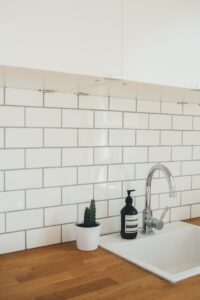Having a small kitchen can be frustrating sometimes. You don’t have much space to move around, and it can feel cramped no matter how tidy you keep it. But here’s the thing—not every solution means knocking down walls or doing a huge remodel. Sometimes, just changing your tiles can make the whole room feel bigger and brighter.
Tiles aren’t just there to cover the floor or protect the walls from splashes. They can completely change the way a room looks and feels. The color, size, shape, and even the way they’re laid out can play tricks on the eye and make your kitchen feel more open.
How Color Affects Space
One of the easiest ways to make a small kitchen feel larger is to choose light-colored tiles. Shades like white, cream, pale grey, or soft beige reflect more light, which makes the space seem more open.
If you have a dark kitchen with little natural light, lighter tiles can instantly brighten things up. Glossy or polished tiles take this a step further by bouncing the light around the room, which helps make the walls or floors feel like they’re expanding.
That doesn’t mean you have to avoid dark colors entirely. You can still use deeper tones, but it’s best to keep them in smaller areas, like a backsplash or a feature wall, so they add interest without making the whole room feel closed in.
Choosing the Right Tile Size
A lot of people think small kitchens need small tiles, but that’s not always true. Large-format tiles can actually make the space feel bigger. When there are fewer grout lines, the floor or wall looks less busy, which gives the illusion of more space.
If you prefer smaller tiles, you can still make them work. Just match the grout color to the tile as closely as possible. This way, the lines don’t stand out too much, and the surface still feels more continuous.
Layout Tricks That Work
The way you lay your tiles can change how a room feels. For example:
- Laying rectangular tiles horizontally can make a narrow kitchen look wider.
- Laying them vertically can draw the eye upward, making the ceiling seem higher.
- A herringbone pattern adds style without overwhelming the space, especially if you stick to lighter colors.
Even the direction of your floor tiles matters. Running them lengthwise along the longest wall can make the room seem to stretch further.
Matching Floors and Walls for Flow
If you want your kitchen to feel bigger, it helps to keep things consistent. Using tiles that are in a similar color family for both the floor and the walls creates a sense of flow. This avoids sharp breaks that can make the space feel chopped up.
That doesn’t mean everything has to be identical. You can choose different finishes or subtle patterns for contrast, but sticking to a connected palette will make the space feel more open.
Why Durability Is Important
In a small kitchen, every detail gets noticed—especially when something starts to wear out. That’s why it’s worth choosing tiles that not only look good but can handle everyday life. Kitchens take a lot of wear and tear from cooking, cleaning, and moving things around.
Many homeowners look for stylish and durable kitchen tiles that can stand up to heat, spills, and scrapes without losing their look. A well-chosen tile can last for years without needing to be replaced, which means your kitchen keeps its fresh, bright appearance for longer.
Playing with Light
Small kitchens often suffer from limited natural light. Tiles can help fix that. Glossy finishes, glass tiles, or even lightly textured surfaces can reflect both sunlight and artificial light to make the space feel brighter.
If you don’t have a window in your kitchen, adding under-cabinet lighting with a shiny splashback can create the same effect. Light bounces off the tiles and spreads around the room, making it feel less enclosed.
Keeping It Simple
In a small kitchen, it’s easy for things to feel cluttered. Too many patterns or colors can make the room look busy and even smaller. That’s why it’s smart to keep your main tile choices simple. Stick to two or three main colors and let accessories bring in the variety.
You can always add personality through things that are easy to change—like plants, a colorful kettle, or bright tea towels—without overwhelming the space.
Combining Style and Practicality
When you’re working with a small space, every choice matters. The best tiles aren’t just about looks—they also make life easier. A floor tile that’s easy to mop or a wall tile that wipes clean after cooking will save you time and stress.
You can even mix materials to get the best of both worlds. For example, porcelain tiles on the floor for strength, and ceramic tiles on the wall for style and shine.
Avoiding Common Mistakes
One mistake people make is picking tiles they love without thinking about how they’ll work in the space. A bold patterned tile might look amazing in a big showroom, but in a small kitchen, it could make the room feel cramped.
Another mistake is ignoring the grout. Dark grout with light tiles can create a grid effect, which might make the space feel smaller. On the flip side, matching grout can keep the surface looking smooth and open.
The Final Look and Feel
The right tiles won’t physically add square footage to your kitchen, but they can make it feel like you’ve gained space. Light colors, smart layouts, and materials that reflect light all help. Consistency in your flooring and wall tiles ties the room together, and durable choices keep it looking fresh for years.
With a bit of thought and the right design decisions, even the smallest kitchen can feel open, bright, and welcoming—without knocking down a single wall.

